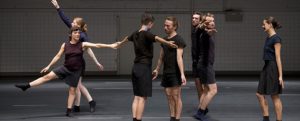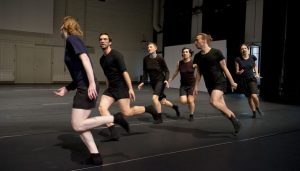It seems like a silly pun: at the new Spring Utrecht festival, a Sacre project could not be missing, of course. But it is just a serious trend. Laurent Chetouane is not the only contemporary dance maker to interpret society through complex group behaviour, on the border between choreography and improvisation. See also, for example, recent work by De Keersmaeker and Charmatz.
The original Sacre du Printemps was commissioned by Diaghilev for the Ballet Russes. The piece actually owes its fame mainly to Stravinsky's pioneering rhythms and transverse tonality. Nijinsky's choreography, which had its premiere in Paris 100 years ago next week, was performed only 10 times. It is Massine's 1920 ballet version, which served as the basis for famous reinterpretations by choreographers such as Maurice Béjart and Pina Bausch. With Béjart, not just a girl is sacrificed but a couple, and Bausch turned the Sacre into a reproach to male society: sacrificing women. In this Jubilee, Chetouane goes a step further. He opposes the sacrifice of human life at all.

Almost shyly, the seven dancers enter the silent, empty stage. It thus becomes a place of expectations and interpretations: everything can become something, but also be undone at any moment. In mutual understanding (glances are exchanged, distance is measured) and with a few abstract swipes of colourful make-up on their faces, the dancers take their first steps, handing out gestures, to each other and to the audience. A hop here and there accelerates, doubling the play with relationships in space and time.
The dancers describe all kinds of possible relationships in this way. It looks like child's play getting out of hand. Before long, the group is running at full speed, giving in, diving deeper and deeper into a kind of excitement, just as nature orders in spring: balls. Fluttering, flapping, twirling, gurgling, cooing, elated, and thus also exotic and strange for those who do not participate. So much for the understandable part of the issue. Less obvious is the proposal that this embalming should involve the death of someone.
Chetouane, who already has a considerable body of work to his name as a director of key texts from the German stage, has also been making dance for a number of years, culminating, for the time being, in 2011 Horizon(s). His regular composer and bassist for the band Selig, Leo Smidthals, composed a 'before' and an 'after' to Stravinsky's two acts. Soberly stated, rhythmically challenging, accented here and there by a soloing flute or violin, the piece builds slowly until the Sacre itself sounds. The flirtations begin to look more and more like a communal ritual. A religious reference changes things from basic interchange between people to social structure. The group as a whole becomes increasingly dominant, constantly spitting out new candidates who invariably move towards the audience, but to start what? Again and again, the offer to share seems in vain. Nor does the constant excitement resolve into a climax or debacle on stage. Increasingly, excitement without sacrifice, without plot, begins to become an acting without purpose.
In front of me, in the front row, a daily newspaper critic is already perusing the Spring programme booklet. A little further on, a fellow conductor is discussing the performance with her clearly irritated partner. I marvel at the images resembling Renaissance frescoes emerging here and there, composed of small gestures and subtle movements, humanistic. Endless detail I read in the way the seven dancers each go their way, despite the group thing or, more accurately, interacting with it. References to what might once have been taken for granted, exalted roles and mythical proportions, now seem like a ridiculous story, nevertheless still claiming victims. Or are they clowns, carnival revellers, is it exuberant naivety, stage on stage to practise evil, not to legitimise it?

On the day I write this, images of a boy with blood on his hands and knives are circulating around the world. He allows himself to be filmed by a passerby. Later, he and his mate walk towards the police, shooting. He is seeking retribution, for previous victims. A few days earlier, after the performance during Spring, Chetouane explained: that he is tired of conflict, bored even, no more sacrifices, preferably not even a contract, because that too excludes people. But what is staying in a group worth, if it does not have the right to expel or not admit people who run amok, as legal philosopher Gijs van Oenen said during a discussion at the festival with disabled dancer Vicky Malin and failed asylum seeker Yunes Omar? Society as an open group, without a contract about inclusion and exclusion, or about who is allowed to use violence and who is not? Keep dancing around each other until you drop? It may seem like a toothless tiger in political terms, a utopia - but the performance is no less so, on the contrary. It remains a good question, posed by Chetouane in a way that is as subtle as it is confrontational: why do we need this sacrifice? Why do people have to lose out again and again, stupidly, to maintain a certain order?
